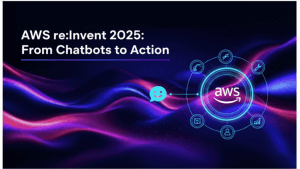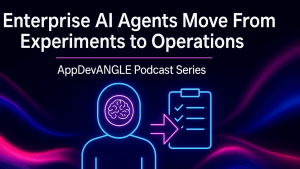Dreamforce 2025 will be remembered for its energy, scale, and the debut of Agentforce 360, Salesforce’s new platform for orchestrating AI agents across its ecosystem coupled with new strategic partnerships. But the more profound story lies beneath the headlines.
Salesforce didn’t just announce new features; it laid the foundation for the next frontier of enterprise AI: a transition from systems that predict and automate to systems that can reason, justify, and explain.
When we look back in a few years, we suspect we’ll recognize that Dreamforce 2025 was the moment Salesforce established leadership in AI reasoning systems and the leap in ROI that will come with it. Mark Benioff, CEO of Salesforce, set the stage well at Dreamforce 2025:
“AI alone is not enough. It’s not enough just to have an LLM. It needs the context.”
In other words, Dreamforce 2025 marked the start of Salesforce’s journey toward trusted AI Decision Intelligence, where AI doesn’t just automate tasks but works with humans to understand implications, explore options, and make smarter decisions. With the introduction of Atlas, its new reasoning engine, its Semantic Data Fabric layer, and its repositioned Einstein Decision Engine, they laid the foundation for what could be the industry’s first truly trusted AI decision-intelligence system. This shift is a hidden gem, a potentially transformative layer that could develop into the reasoning brain of the Agentforce 360 ecosystem.
Video Summary
Watch by clicking on the image below.
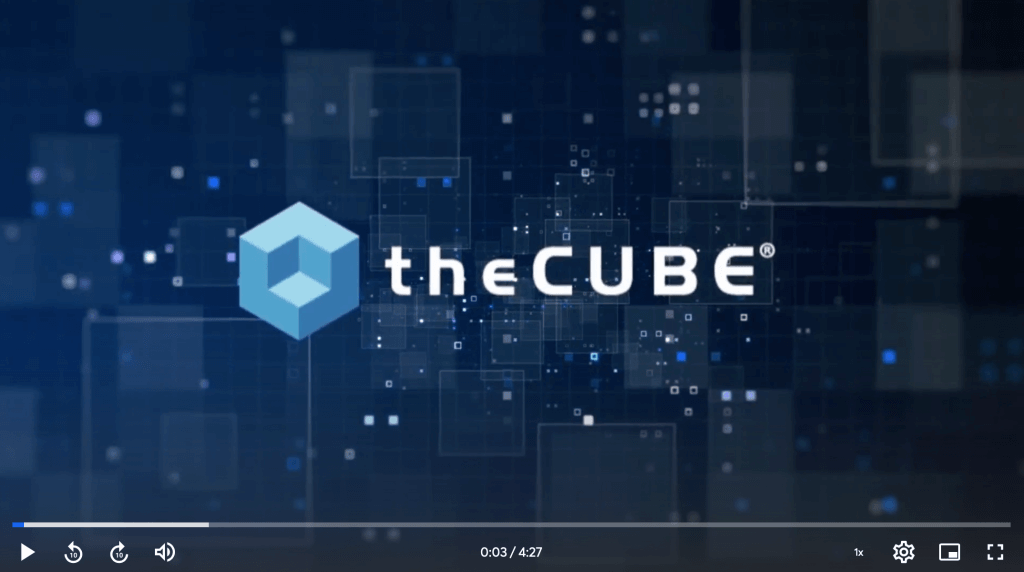
Agentforce 360: A Digital Labor Platform
Agentforce 360 serves as the operational hub for Salesforce’s “Agentic Enterprise.” It combines AI agents across Sales Cloud, Service Cloud, Marketing Cloud, Slack, and Data Cloud, creating an “ambient” AI layer that collaborates with humans to automate and improve workflows.

Few companies have done more to advance the conversation around digital labor transformation than Salesforce and perhaps Deloitte. Both have been among the most active advocates of AI agents to augment the enterprise workforce. Digital labor transformation is not about replacing people, but about rearchitecting work so that humans and intelligent agents operate side by side, each amplifying the other’s strengths.
The data from our recent Digital Labor Transformation Index survey shows that this shift is already happening: 71% of business leaders believe they will be the last generation to manage human-only workforces. That belief highlights a growing consensus that agentic AI will soon become the foundation of how companies create value, coordinate work, and expand human potential.
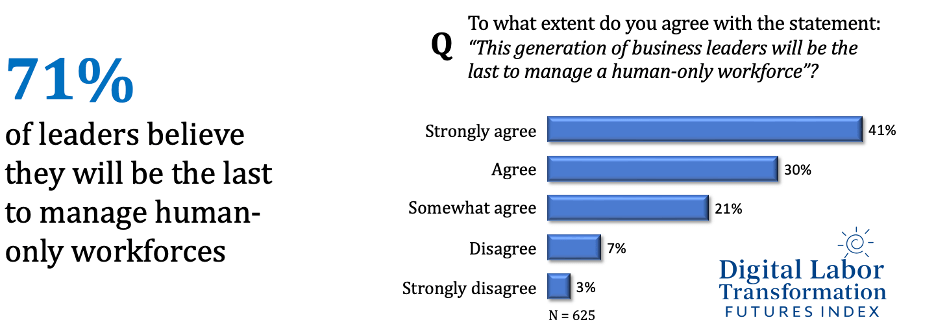
Agents now have real-time observability, built-in trust controls, and low-code builder tools. More importantly, Salesforce has designed Agentforce 360 not just to scale automation, but to support decision orchestration, the ability for AI to reason about, test, and improve the decisions behind those workflows.
This isn’t just another product launch. It’s a platform for a strategic transformation: shifting from AI that automates tasks to AI that reasons, justifies, and acts, helping humans understand consequences, explore alternatives, and make better decisions. This strategic architecture, coupled with a digital labor mindset, though understated in the keynotes, is what positions Salesforce to lead the next era of AI.
Semantic Data Fabric: From Data to Knowledge
Underneath Agentforce lies Salesforce’s most strategic infrastructure innovation, the Semantic Data Fabric. This is more than data integration: it is a knowledge layer that transforms raw data into machine-understandable business concepts, relationships, meanings, and rules.
This layer connects what the business wants to discuss (customers, contracts, cases, supply-chain disruptions) with what machines can understand. Without this semantic layer, AI is just crunching numbers, a large engine analyzing historical data. With it, AI starts to grasp context and know how.
And this matters because Atlas, Salesforce’s new reasoning engine, uses that semantic context. You can’t reason effectively with data alone; you need knowledge. Atlas leverages it to connect steps in a workflow, interpret cause and effect, and reason through multiple actions. The Semantic Data Fabric enables Atlas to potentially go beyond simple automation and become a collaborative cognitive partner.

The Twin Engines of Decision Intelligence
At the heart of Salesforce’s AI transformation, in our view, are two complementary engines that, together with Agentforce 360 platforms, redefine what enterprise AI can do: Atlas and Einstein.
The Atlas Reasoning Engine, described by Salesforce as the brain of Agentforce, provides the deliberative reasoning and orchestration layer that enables AI agents to think before they act. It performs multi-step predictive reasoning, manages tool selection and chaining, and grounds every decision in the Semantic Data Fabric, Salesforce’s shared knowledge model spanning CRM, Data Cloud, and Slack. Atlas uses this semantic grounding to interpret business context, understand intent, and plan actions that align with business logic and policy constraints. Salesforce says it’s the first large-scale step toward System-2 AI, reasoning that is explainable, auditable, and adaptable across workflows.
The Einstein Decision Engine, in contrast, is the execution-intelligence layer. It brings predictive analytics, optimization, and “what-if” scenario simulation into agentic workflows, quantifying trade-offs and projected outcomes using statistical/predictive models grounded in historical patterns and enterprise context. Einstein can use techniques like forecasting and reinforcement-style optimization to suggest actions and predict likely impacts, then feed observed results back into the system for ongoing improvement. In short, Einstein puts probabilistic AI decision support into practice. Currently, Einstein runs predictive, correlation-based simulations. Although it now performs these simulations, it lays the groundwork for future integration of consequence-aware decision-making, causal analysis, and counterfactual analysis, which will be the next major milestones as Atlas and the semantic layer develop.
In simple terms, Atlas determines how an agent thinks and plans its actions; Einstein identifies which options provide the highest value and confidence. Together, they transform Salesforce’s AI ecosystem from a collection of tools into a closed-loop decision-making system built on a semantic data fabric.
This architecture enables Salesforce to shift decisively from process automation to genuine AI decision intelligence. Over time, Atlas and Einstein will empower a new generation of agents that can reason through complex trade-offs, explain their logic, and improve with each decision cycle, turning digital labor from just a productivity layer into a strategic thinking partner for the enterprise.
Why It Matters
At theCUBE Research, we believe the next frontier of enterprise AI will be defined not by larger models or better task automation, but by decision intelligence: an era in which AI agents can do more than just predict outcomes; they can make trustworthy judgments. This represents a pivotal evolution from today’s generation of large language models (LLMs), which remain largely correlative and probabilistic, offering predictions without a proper understanding of why outcomes occur or how they might change under different conditions.
Our Agentic AI Futures Index survey of 625 enterprise professionals involved in agentic AI initiatives highlights this shift: 73% plan to invest in AI reasoning and decision-making capabilities over the next 18 months, and more than one-third see this as a strategic necessity. The reason is straightforward: enterprises are looking for higher-ROI use cases, especially in knowledge work, where AI agents can handle ambiguity, interpret context, and assist humans in making better decisions instead of just automating repetitive tasks within workflows.
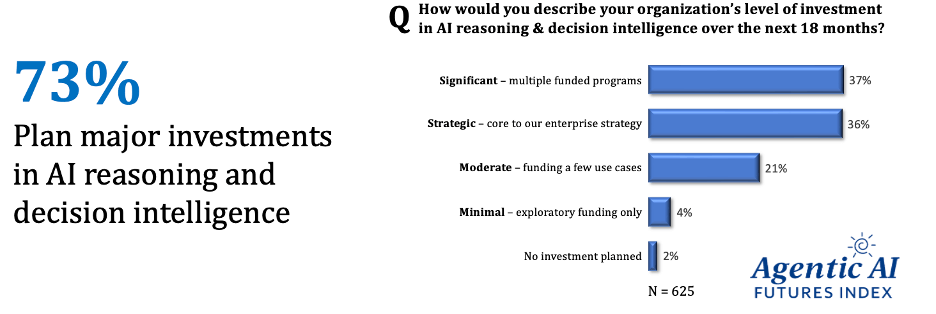
But achieving this transformation will require more than just scaling foundation models. Enterprises must now develop an entire ecosystem around LLMs and generative AI, one specifically crafted for decision intelligence. This involves going beyond text generation to include semantic understanding, multi-step reasoning, and ultimately causal modeling that enables systems to interpret dependencies, test interventions, and explain outcomes.
Salesforce is well-positioned to lead this enterprise-critical space by transitioning from:
- Data to knowledge
- Predictions to judgments
- Correlation to causation
- Hindsight to foresight
- Black Boxes to explanations.
Each of these transitions deepens enterprise AI’s cognitive capabilities. The aim isn’t to replace human decision-makers but to allow humans and AI agents to think together, merging human judgment with AI that understands context, consequences, and causality. The result: more informed, explainable, and impactful decisions,
Next-generation agents will do more than automate workflows; they will participate in them. They’ll explore what-if scenarios, run simulations, and reveal the ripple effects of various actions. This turns digital coworkers into collaborative decision-marketing partners, giving human workers new “super powers” to better diagnose root causes, predict downstream impacts, and plan better paths forward.
But reasoning alone isn’t enough. It must be trustworthy reasoning—AI that can justify its logic, trace its evidence, and make its decision-making process transparent and auditable. Trust, perhaps, the most critical part of the future of enterprise AI. If AI agents are going to be part of the workforce of the future, especially in regulated industries, they must earn trust through transparency and traceability. Each recommendation or automated decision should link to a verifiable chain of reasoning, from data inputs, through semantic context and modeled relationships, to the final outcome. This kind of explainability enables leaders to ask why a system reached a conclusion and to challenge or refine it based on evidence.
This is precisely where, in our view, Salesforce is building momentum. The Semantic Data Fabric offers shared meaning across systems, Atlas provides the reasoning architecture, and Einstein adds the predictive and simulation layer. Together, they form a cohesive framework that can shift from correlation-based automation to cause-aware reasoning and explainable decision-making.
The enterprise market is ready for it. Organizations have also prioritized AI trust as a key investment area over the next 18 months, as the Agentic AI Futures Index has indicated.

Ultimately, this matters because the future of enterprise AI isn’t about doing things faster or more efficiently; it’s about thinking more impactfully. Trusted reasoning is the key difference that will separate those who use AI from those who lead with it.
Roadmap Feasibility
While semantic and causal reasoning, along with explainable decision intelligence, grounded in trustworthy AI judgments, may seem ambitious, the journey toward this goal is quite certain. The necessary technologies are rapidly emerging, and Salesforce has already assembled many of the essential ingredients to create this future.
Here’s why the theCUBE Research believes this vision is not only feasible, but increasingly inevitable:
- A Robust Semantic Foundation Already in Place: Salesforce’s Data Cloud and Semantic Data Fabric offer some of the most advanced semantic infrastructures in the enterprise software market. This architecture provides AI agents with a shared understanding of business context. In essence, it converts fragmented data into a knowledge layer that AI can interpret, reason about, and act upon. This is the fundamental foundation for trustworthy reasoning, because without semantic grounding, no AI system can truly explain its logic.
- A Reasoning Core Designed for Extension: With Atlas as the reasoning brain of Agentforce, Salesforce now has a platform capable of multi-step, deliberative reasoning. Atlas brings together semantic understanding, planning, and tool orchestration, and, importantly, it’s been designed to integrate hybrid reasoning architectures that can evolve. While Einstein remains focused on predictive and optimization-based decision support, Atlas integration introduces a reasoning engine flexible enough to eventually incorporate causal modeling and counterfactual simulation, two capabilities essential for explainable AI decision-making. This architectural foresight gives Salesforce a credible path to evolve from probabilistic “what-if” analysis to true cause-aware (consequential) reasoning.
- Multi-Model and Multi-Partner Ecosystem: Salesforce’s expanding partner ecosystem strengthens its technical position dramatically. Its partnerships with OpenAI (GPT-5), Anthropic (Claude), and Google (Gemini) allow Atlas and Einstein to tap into the strengths of multiple reasoning modalities as they evolve into the future. This multi-model orchestration ensures that Salesforce’s reasoning stack can adapt as the state of the art evolves. These partnerships also create room for collaboration in the next frontier, integrating causal inference, neuro-symbolic reasoning, and graph-based knowledge representations into the decision-intelligence loop. This broader ecosystem is what makes Salesforce’s roadmap feasible at scale rather than conceptually interesting in isolation.
- Governance and Trust Already Embedded: Agentforce 360’s Command Center and built-in observability layer establish the governance foundation that every enterprise-grade reasoning system needs. Scoring models, auditing AI decisions, and maintaining explainability across thousands of workflows are essential; they’re prerequisites for gaining trust. By making trust and governance native to its platform, Salesforce can ensure that reasoning and decision-making are both transparent and controllable. This is a clear differentiator compared to most open-model frameworks, which depend on external governance layers rather than embedded accountability mechanisms.
- Workflow Integration That Closes the Loop: Unlike other AI vendors, Salesforce doesn’t just analyze or advise; it manages the workflows where decisions take place. Its scope across sales, marketing, service, and operations means that reasoning, simulation, action, and feedback happen in a continuous cycle. This close integration is what will allow learning systems to improve on their own, based on real-world performance data. In a sense, Salesforce has the rare ability to embed decision intelligence directly into the core of the modern enterprise.
As Atlas, Einstein, and the Semantic Data Fabric mature together, along with their agentic ecosystem, Salesforce should jump on this opportunity to lead. From a fully speculative 3-year roadmap perspective envisioned by theCUBE Research, the following path into the future is highly feasible if Salesforce executes boldly:
- 2025–2026: Semantic–Causal Fusion: Extend the Semantic Data Fabric into a live knowledge graph with dependency metadata and event lineages. Extend entity relationships with causal mechanisms. Integrate Atlas with full reasoning traces and transparent decision logs so every step is explainable.
- 2026–2027: Causal APIs and “What-If 2.0”: Introduce APIs for developer-facing intervention and counterfactual analysis. Allow Einstein to quantify trade-offs and simulate counterfactual outcomes, enabling auditable, data-driven what-if reasoning for regulated, high-stakes workflows. Help it understand and rank which factors are more influential in achieving an outcome.
- 2027–2028: Multi-Agent, Consequence-Aware Operations: Enable specialized agents (risk, marketing, supply chain) and agentic workflow frameworks that can collaborate through Atlas, while Einstein optimizes cross-functional trade-offs; leaders oversee the system with a unified decision-intelligence dashboard.
If successfully executed, Salesforce can progress beyond its CRM heritage to become the decision-intelligence backbone of the enterprise, where reasoning, judgment, and trust come together to produce outcomes that are not only faster but also smarter and demonstrably justified. This is the future of agentic AI, and it’s available to take. The market needs and desires genuine semantic and causal reasoning to support the workforces of the future. As shown in the Agentic AI Futures Index, those involved in enterprise agentic AI initiatives understand and would embrace causal AI techniques if they were made accessible within agentic AI platforms and tools.

It’s important to note that Salesforce is not alone in this space, and as we know, given the warp speed of innovation and change in the agentic AI marketplace, an initial advantage can rapidly deteriorate.
Microsoft and IBM, for example, are credible contenders in consequence-aware AI: Microsoft is pushing causal ML into Azure and Power Platform via Project Causica (causal discovery & inference using deep learning) and ShowWhy (causal no/low-code framework), while IBM is pairing Granite with partners like Geminos and causaLens to emphasize explainability in regulated domains, and has their own causal R&D underway in the context of watsonx BI.
The key advantage, however, lies in where the intelligence resides. Salesforce’s strength is architectural proximity: Atlas and Einstein are integrated directly into the points where decisions are made, Sales, Service, Marketing, Slack, and Data Cloud, enabling reasoning, simulation, and action to occur within a single loop, with governance and telemetry embedded into the platform. This gives Salesforce an early advantage in providing a fully integrated decision-making engine, rather than just a reasoning feature.
The Takeaway
The path to trustworthy AI reasoning and decision-making is no longer just a theoretical goal. It is both practically attainable and strategically aligned with not only Salesforce’s current strengths but also where enterprise leaders want to see agentic AI evolve. The key ingredients, semantic grounding, a reasoning engine (Atlas), predictive simulation (Einstein), embedded governance, and a multi-model partner ecosystem, are already available to them to make it happen.
In many ways, Salesforce now faces the same turning point it did twenty years ago, when it transformed CRM from a static database into a dynamic engagement platform. The difference this time is that the stakes are higher: it’s about evolving AI itself from a generative pattern-matching platform into a trustworthy cognitive infrastructure for business.
The opportunity is obvious and huge: by combining semantics, reasoning, and governance into a single platform, Salesforce can lead the next stage of enterprise AI: one where digital labor becomes a cognitive partnership, and decisions are not only quicker but also smarter, explainable, and justified.
This is Salesforce’s moment to go beyond automation and shape the era of AI reasoning. Few companies worldwide are as well-positioned to turn this vision into reality. The foundation is set, now it’s about conviction, speed, and leadership.
Fortune favors the bold.
–> Read (or watch) more about Salesforce’s Strategic Direction:
Breaking Analysis | Salesforce’s Next Era – The Agentic Enterprise


